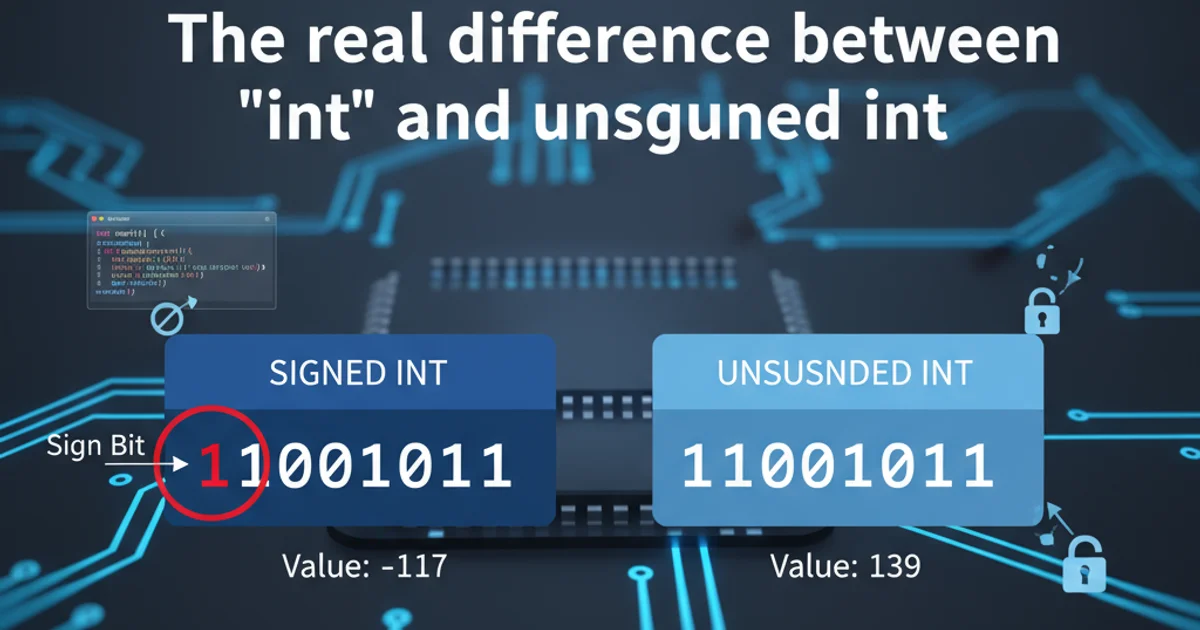The real difference between "int" and "unsigned int"
Categories:
The Real Difference Between 'int' and 'unsigned int' in C

Explore the fundamental distinctions between signed and unsigned integers in C, understanding their memory representation, value ranges, and practical implications for programming.
In the C programming language, int and unsigned int are fundamental data types used to store whole numbers. While they both occupy the same amount of memory on most systems (typically 4 bytes), their interpretation of the bits stored in that memory differs significantly. This difference impacts the range of values they can represent and how arithmetic operations are performed. Understanding these distinctions is crucial for writing robust, efficient, and bug-free C code, especially when dealing with low-level operations, bit manipulation, or specific data ranges.
Memory Representation and Value Ranges
The core difference between int and unsigned int lies in how they utilize the most significant bit (MSB) of their memory allocation. For a signed int, the MSB is reserved to indicate the sign of the number (0 for positive, 1 for negative), typically using two's complement representation for negative numbers. For an unsigned int, all bits are used to represent the magnitude of the number, meaning it can only store non-negative values (zero and positive integers).
Consider a 4-byte (32-bit) integer. An int can typically range from approximately -2 billion to +2 billion, while an unsigned int can range from 0 to approximately 4 billion. This doubling of the positive range for unsigned int comes at the cost of losing the ability to represent negative numbers.
flowchart TD
A[Integer Type] --> B{Signed (int)?}
B -- Yes --> C[MSB for Sign]
C --> D[Range: -2^N-1 to 2^N-1 - 1]
B -- No --> E[All Bits for Magnitude]
E --> F[Range: 0 to 2^N - 1]
D & F --> G[N = Number of bits (e.g., 32)]Decision flow for integer type representation and range.
#include <stdio.h>
#include <limits.h>
int main() {
printf("Size of int: %zu bytes\n", sizeof(int));
printf("Range of int: %d to %d\n", INT_MIN, INT_MAX);
printf("\nSize of unsigned int: %zu bytes\n", sizeof(unsigned int));
printf("Range of unsigned int: %u to %u\n", 0, UINT_MAX);
return 0;
}
Demonstrating the size and range of int and unsigned int.
Arithmetic Operations and Type Coercion
When performing arithmetic operations involving both signed and unsigned integers, C's type promotion rules come into play. If an operation involves an int and an unsigned int, the int is typically converted to an unsigned int before the operation. This can lead to unexpected results if not handled carefully, especially when negative signed numbers are involved.
For instance, a negative int value, when converted to an unsigned int, will become a very large positive number. This behavior is a common source of bugs, particularly in comparisons or loop conditions where a signed counter might interact with an unsigned limit.
#include <stdio.h>
int main() {
int signed_val = -10;
unsigned int unsigned_val = 5;
// Comparison
if (signed_val < unsigned_val) {
printf("Signed is less than unsigned (as expected)\n");
} else {
printf("Signed is NOT less than unsigned (due to type promotion)\n");
}
// What happens when -10 is treated as unsigned?
printf("\n-10 as signed int: %d\n", signed_val);
printf("-10 as unsigned int: %u\n", (unsigned int)signed_val);
return 0;
}
Illustrating type promotion issues in comparisons between signed and unsigned integers.
Practical Use Cases and Best Practices
Choosing between int and unsigned int depends heavily on the nature of the data you are storing:
int: Use for quantities that can be positive, negative, or zero. This is the default choice for most general-purpose integer arithmetic.unsigned int: Use when you are certain that a value will never be negative, such as counts, sizes, bitmasks, or memory addresses. Usingunsigned intin these cases can provide a larger positive range and can sometimes simplify bitwise operations by avoiding sign extension issues.
Best Practices:
- Be explicit: When interacting with APIs or libraries that expect specific signedness, ensure your variables match. Explicit casting can sometimes clarify intent, but be aware of its implications.
- Avoid mixing: Try to avoid mixing signed and unsigned types in the same expression or comparison unless you fully understand the type promotion rules and their consequences.
- Use
size_tfor sizes/indices: For sizes of arrays, loop counters, and memory allocation sizes, prefersize_t(which is anunsignedtype) as it is guaranteed to be large enough to hold the size of any object in memory.
size_t is generally preferred over int or unsigned int because it is guaranteed to be large enough to represent the size of any object in memory and is designed for this purpose.